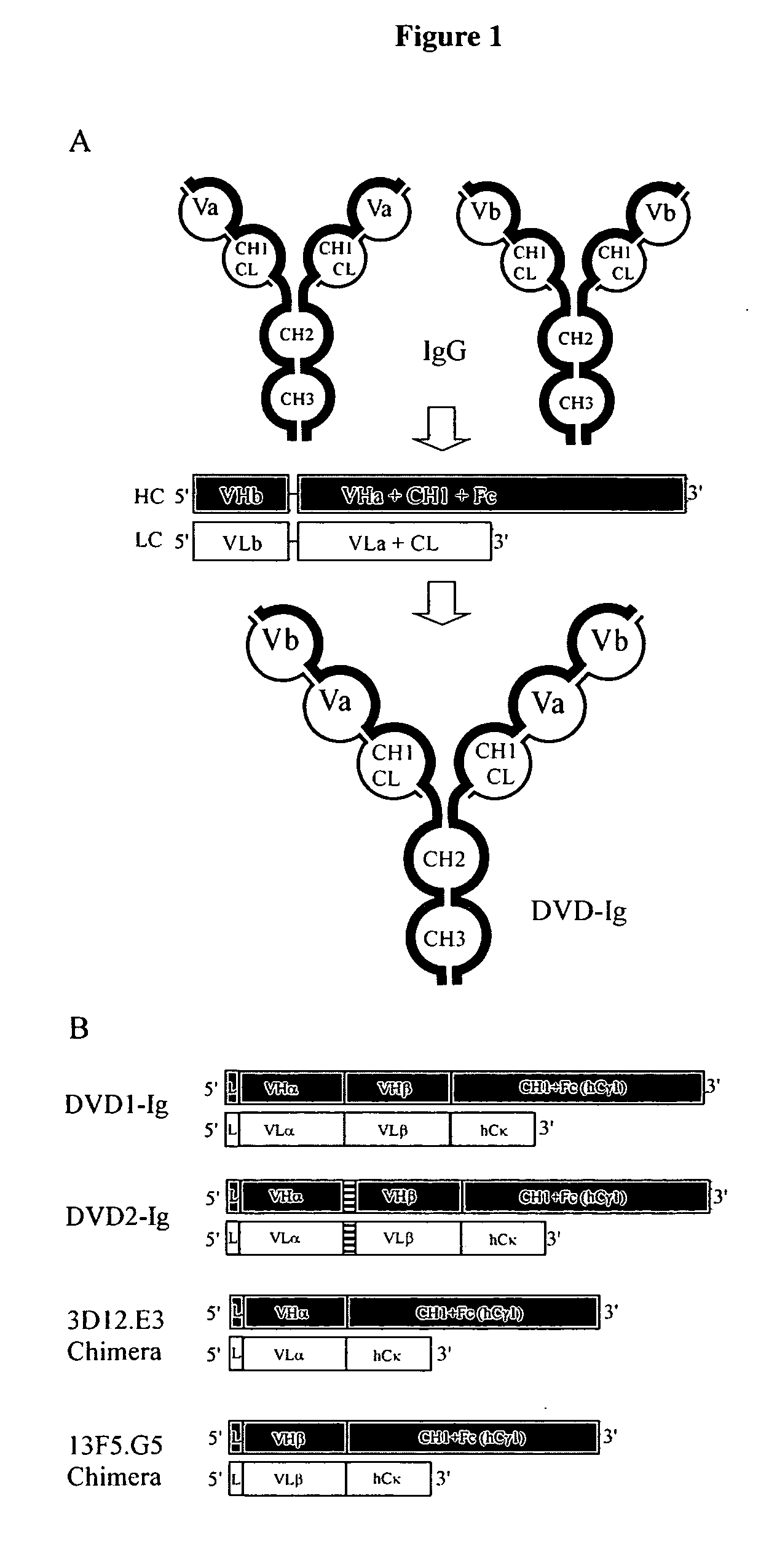Dual variable domain immunoglobulin and uses thereof
a technology of immunoglobulin and variable domain, applied in the field of multivalent and multispecific binding proteins, can solve the problems of reduced production yield, inability to yield homogeneous preparations, and complex purification procedures
- Summary
- Abstract
- Description
- Claims
- Application Information
AI Technical Summary
Benefits of technology
Problems solved by technology
Method used
Image
Examples
example 1
Generation of Dual Variable Domain Immunoglobulin (DVD-Ig)
[0225] The dual variable domain immunoglobulin (DVD-Ig) molecule is designed such that two different light chain variable domains (VL) from the two different parent mAbs are linked in tandem directly or via a short linker by recombinant DNA techniques, followed by the light chain constant domain. Similarly, the heavy chain comprises two different heavy chain variable domains (VH) linked in tandem, followed by the constant domain CH1 and Fc region (FIG.1A).
Example 1.1
Generation of Murine Monoclonal Antibodies to IL-1α and IL-1β
[0226] Monoclonal Antibodies to IL-1α and IL-1β were generated as follows using Hybridoma technology well known in the art.
Example 1.1.A
Immunization of Mice
[0227] Purified recombinant human IL-1α and murine IL-1β (R&D Systems) were used as immunogens as well as coating antigens in titer assays and screening ELISA. Immunizing dosages ranged from 5.0 to 20.0 μg / mouse / injection for all antigens for bo...
example 1.1
Cloning and Sequencing of the Murine Monoclonal Antibodies to IL-1α and IL-1β
[0234] Cloning and sequencing of the variable heavy (VH) and light (VL) genes of all anti-IL-1a / b mAbs described in Table 1 and additional antibodies were carried out after isolation and purification of the total RNA from the each hybridoma cell line using Trizol reagent (Invitrogen) according to the manufacturer's instructions. Amplification of both VH and VL genes was carried out using the IgGVH and IgκVL oligonucleotides from the Mouse Ig-Primer Set (Novagen, Madison, Wis.) with One-tube RT-PCR kit (Qiagen) as suggested by the manufacturer. DNA fragments resulting from productive amplifications were cloned into pCR-TOPO vector (Invitrogen) according to the manufacturer's instructions. Multiple VH and VL clones were then sequenced by the dideoxy chain termination method using an ABI 3000 sequencer (Applied Biosystems, Foster City, Calif.). The sequences of all mAb VL and VH genes are shown below in Table ...
example 1.2
Generation and Characterization of Murine-Human Chimeric Antibodies
[0235] All mAbs described above were converted to chimeric (with human constant region) and expressed, purified, and characterized to confirm activity and will be used as controls for subsequent DVD-Ig analysis. To convert 3D12.E3 into chimeric form, 3D12.E3-VL was PCR amplified using primers P1 and P2; meanwhile human Ck gene (in pBOS vector generated in-house at ABC) was amplified using primers P3 and P4. Both PCR reactions were performed according to standard PCR techniques and procedures. The two PCR products were gel-purified, and used together as overlapping template for the subsequent overlapping PCR reaction using primers P1 and P4 using standard PCR conditions. The final PCR product, the chimeric light chain 3D12.E3-VL-hCk, was subcloned into pEF6 TOPO mammalian expression vector (Invitrogen) by TOPO cloning according to the manufacturer's instructions. Table 3 shows the PCR primers' sequences:
TABLE 3P1:5...
PUM
| Property | Measurement | Unit |
|---|---|---|
| dissociation constant | aaaaa | aaaaa |
| surface plasmon resonance | aaaaa | aaaaa |
| half life | aaaaa | aaaaa |
Abstract
Description
Claims
Application Information
 Login to View More
Login to View More - R&D
- Intellectual Property
- Life Sciences
- Materials
- Tech Scout
- Unparalleled Data Quality
- Higher Quality Content
- 60% Fewer Hallucinations
Browse by: Latest US Patents, China's latest patents, Technical Efficacy Thesaurus, Application Domain, Technology Topic, Popular Technical Reports.
© 2025 PatSnap. All rights reserved.Legal|Privacy policy|Modern Slavery Act Transparency Statement|Sitemap|About US| Contact US: help@patsnap.com


